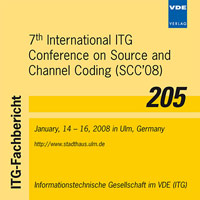On Bandwidth Partitioning in FDD Block-Fading Single-UserMISO/SIMO Systems
Konferenz: SCC'08 - 7th International ITG Conference on Source and Channel Coding
14.01.2008 - 16.01.2008 in Ulm, Germany
Tagungsband: SCC'08
Seiten: 6Sprache: EnglischTyp: PDF
Persönliche VDE-Mitglieder erhalten auf diesen Artikel 10% Rabatt
Autoren:
Ivrlac, Michel T.; Nossek, Josef A. (Lehrstuhl für Netzwerktheorie und Signalverarbeitung, Technische Universität München)
Inhalt:
We consider the problem of how to partition the available bandwidth of a class of communication systems into sub-bands for the uplink, the downlink, and the feedback in an optimized way which suits the system as a whole. We consider frequency division duplex systems which employ multiple antennas in the downlink only at the transmitter, and in the uplink only at the receiver. In the downlink, the transmitter applies coherent beamforming based on quantized channel information which is obtained by feedback from the receiver. As feedback takes away resources from the uplink – which could otherwise be used to transfer payload data – it is highly desirable to reserve the »right« amount of uplink resources for the feedback. Under the assumption of random vector quantization, and a frequency flat, independent and identically distributed block-fading channel, we derive closed-form expressions for both the feedback quantization and bandwidth partitioning which jointly maximize the sum of the average payload data rates of the downlink and the uplink. While we do introduce some approximations to facilitate mathematical tractability, the analytical solution is asymptotically exact as the number of antennas approaches infinity, while for systems with few antennas, it turns out to be a fairly accurate approximation. In this way, the obtained results are not only attractive from a theoretical point of view, but are meaningful as well for practical communication systems, where usually only a few antennas are employed.


